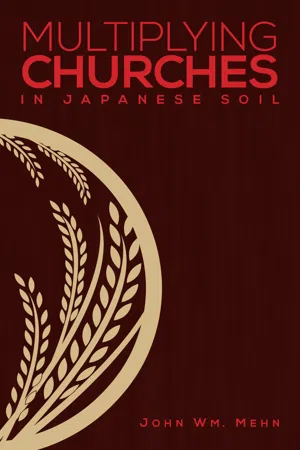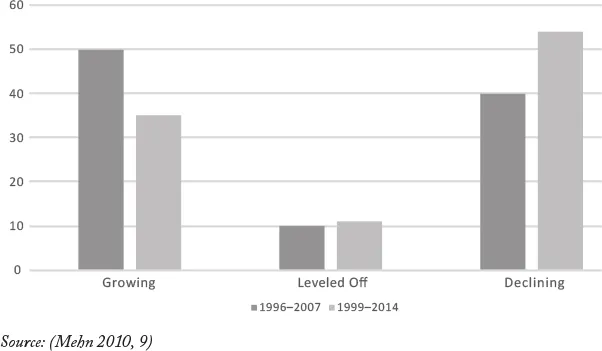![]()
GOSPEL PENETRATION IN JAPANESE SOIL
The Japanese soil has been a great challenge for the gospel, yet the gospel endures in Japan. The good news of God’s reconciliation with man has resulted in many Japanese becoming children of God. And the church, the body of Christ, exists among the Japanese. The impact of a small number of Japanese believers is far greater than any collected statistics on the size of the church. However, as shared in the Introduction, the penetration and growth of the gospel in the soil of Japan has been meager and slow-paced.
We have considered some questions and opportunities in the task of advancing the Christian gospel in Japan. Now we turn to the response of the Japanese to the gospel. First, we will take a comprehensive look at the current situation in Japan. This hard look may seem difficult, but this baseline information will further instruct us as we consider ministry innovations from practical case studies. Then we will consider major reasons for the lack of response in Japan followed by some practical ways to address these hindrances.
GOSPEL PENETRATION IN JAPAN
Japan has a small percentage of Christians and Christian activity. Of the 126.9 million people of Japan, current membership of all Christian churches in Japan totals 1,065,049 [617,056 Protestants, 437,742 Catholics, and 10,251 Orthodox] (see Table 1) putting the total percentage of all Christians in Japan at 0.84 percent (JCE6 2016, 11). A reliable barometer of spiritual activity is weekly church attendance, and on any given Sunday about 280,000 Japanese are in a Protestant church service, which is about 0.22 percent of the population (CIS 2013, 5). Makito Goto believes these percentages are inflated reports and probably in reality much lower (Goto 2011, 15).
Table 1. Japan Churches and Membership
| Number of Churches | Total Membership |
| Catholic | 1,000 | 437,742 |
| Orthodox | 70 | 10,251 |
| Protestant | 7,969 | 617.056 |
| TOTAL | 9,039 | 1,065,049 |
Source: (JCE6 2016, 11)
Japan contains one of the most homogeneous people groups on the planet. With a large middle-class they are culturally and ethnically similar. This large people group is the second largest unreached people group in the world (Joshua Project 2015). Besides the Japanese, other people groups are present in Japan; however, they are very small including the Ainu (an indigenous group), the Burakumin (the outcasts), and several ethnic groups on the Ryukyu Islands (Okinawa). Japan also has large numbers of Chinese (665,847) and Koreans (457,772). There are also many Filipinos (229,595) and immigrants from South America with Japanese ancestry (Joshua Project 2015; JCE6 2016, 123).
The Church in Japan
Japan has a low number of very small churches. Table 1 lists 9,039 churches in Japan [7,969 Protestant, 1,000 Catholic, and 70 Orthodox] (JCE6 2016, 11). Japan is far from a country saturated with churches, as there remain many unchurched areas. Twenty-four cities still do not have a single church. Over 1,800 rural areas including towns and villages linger without a church, of which nine hundred are considered strategic for establishing churches. Also, ninety-six cities and forty-two towns and villages have only one church but are considered underchurched areas because the population exceeds twenty thousand people (CIS 2013, 5). Church Information Service has calculated there is one Protestant church for about sixteen thousand Japanese (CIS 2013, 4) making the average size of a church only thirty-four. Furthermore, most churches are indeed very small (see Table 2) with 82 percent of churches under fifty attendees, 62 percent under thirty attendees, and 31 percent under fifteen attendees (JMR 2015, 7).
Table 2. Size of Protestant Churches in Japan
| Size of Churches (attendance) | Percentage of Total |
| Under 50 people | 81.5% |
| Under 30 people | 62.4% |
| Under 15 people | 30.6% |
Source: (JCE6 2016, 33)
These 9,039 churches are pastored by 11,703 professional clergy [10,198 Protestant, 1,451 Catholic, and 54 Orthodox] of which 1,009 are foreigners according to Table 3 (JCE6 2016,11).
Table 3. Japan Churches and Pastors
| Number of Churches | Pastors (foreign) |
| Catholic | 1,000 | 1,451 (541) |
| Orthodox | 70 | 54 |
| Protestant | 7,969 | 10,198 (468) |
| TOTAL | 9,039 | 11,703 (1,009) |
Source: (JCE6 2016, 11)
Seventy-two percent of these pastors are over sixty years old (see Figure 2). This and other factors contribute to a continued shortage of trained pastors to replace soon-to-be retired pastors and to fill current positions. Currently 3.8 percent of churches (300) still are without a pastor (muboku) and 7 percent of churches (560) share their pastor with another church (see Table 4). Some denominations are particularly hard hit with 20–40 percent without pastors (JCE6 2016, 45).
Table 4. Pastoral Shortage
| Pastors | Sharing Pastors
(kenmu) | Without Pastors
(muboku) |
| Number of Churches | 6,670 | 560 | 300 |
| Percentage | 84.4% | 7.1% | 3.8% |
Source: (JCE6 2016, 45)
The number of foreign missionaries serving in Japan is under 1,700 (JCE6 2016, 134). This is a decline from a peak of nearly 2,800 in the mid-1980s. In recent years, there has been an influx of missionaries from Asia especially South Korea. In a recent study 50 percent of missionaries reported their primary role to be church planting ministry (JMR 2015, 23–28).
Church Growth
The number of congregations in Japan increased for over seventy years, but recently this growth rate slowed to a near crawl. In a study of churches in Japan from 1945–1985, Toyotome calculated the average annual growth rate was 4.15 percent (1985, 230) but Montgomery determined the rate from 1960–1990 had dropped to 1.7 percent (1997, 18). Parrish assessed the average annual growth rate of Japanese churches from 1997–2007 as merely 0.10 percent (2008, 19). In the late 1980s, one new church was founded per forty to fifty churches; at the end of the 1990s, this ratio of existing churches to new churches had swelled to nearly 250.
For the last several years the net gain in churches has been a negative number in Japan. Exact causes for this decline are unknown, though churches have been closing at an alarming pace according to church researchers. In 2002, Mitsumori reported 271 churches closed, which is “the largest number in our experience” (2002, 6). No studies have been conducted, but the causes for church closings are assumed to be aging pastors and church members.
An earlier study of CIS church data of all Protestant denominations in Japan during the ten-year period from 1996 to 2007, 50 percent of the denominations were growing, 10 percent were remaining the same size, and 40 percent were declining (Mehn 2010, 9). These figures hold true whether the denomination is evangelical or charismatic while the conciliar The United Church of Christ in Japan (Kyōdan) had actually increased just slightly in total number of churches. Over this same period, the number of independent churches declined by 14 percent. A similar study with updated data from 1999–2014 (see Figure 3) shows overall decline continuing in the number of churches with over 65 percent of Japanese denominations leveling off or declining (JCE6 2016, 27–29).
Figure 3. Decline of Denominations
After 150 years of Protestant mission, Japan remains relatively unreached by the gospel. Even the accelerated mission activity after World War II failed to substantially improve the situation (Hesselgrave 2005, 138). Kenneth Dale’s 1996 evaluation of the spiritual soil of Japan as thorny is just as accurate today; in fact, the church in Japan may be in a worse overall situation. In the present climate, we cannot proceed with the status quo as it means the church in Japan would continue to decline. A few years ago, Parrish estimated that at the current rate, for Japan to reach a target of one church per one thousand people, an astronomical figure of nearly 2,800 years would be needed (2008, 19; see also Shibata 2016, 56–58).
Newer Vision
What is needed is not just the addition of fifty to sixty new churches each year but reproduction and even multiplication of the existing eight thousand churches and the planting of masses of new churches and movements. Braun shared this same outlook forty-five years ago, as “only a grand-scale church-planting enterprise” and the “multiplication of churches in large numbers is essential to the fulfilling of God’s wi...



